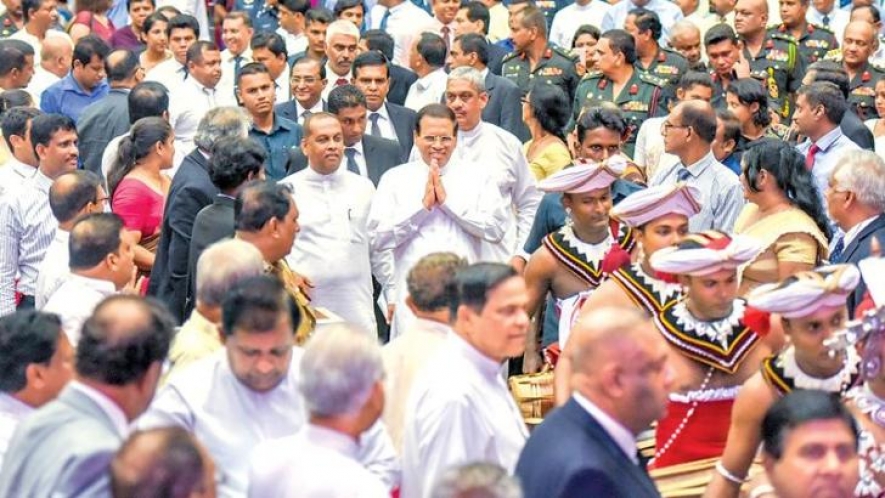SDG 2030 FOR A NATIONAL AGENDA
by Sugeeswara Senadhira
Last week, the most comprehensive futuristic vision of Sri Lanka, “Sustainable Sri Lanka: Vision and Strategic Path” was presented to President Maithripala Sirisena. This was within the framework of the 17 Sustainable Development Goals (SDG) and 2030 Agenda adopted by the United Nations member states, including Sri Lanka, in 2015. Within this framework, all countries are expected to set out their vision for 2030 and Sri Lanka fulfilled its task by producing this comprehensive document.
Addressing a galaxy of high profile audience comprising top economists, diplomats, academics, politicians and social leaders, President Sirisena said, this document prepared by the Presidential Expert Committee (PEC), which is unique to the country, would serve as the base document in the public consultation process to formulate consistent national policies that will guide Sri Lanka to become a truly sustainable nation by year 2030.
In his address he said: “The ‘Balanced, Inclusive, Green Growth’ (BIGG) also goes hand in hand with our nation’s long tradition of adhering to a ‘middle-path’ approach that has helped us remain a resilient nation for millennia. I applaud this innovative path suggested by PEC, chaired by Prof Mohan Munasinghe, an internationally renowned expert on sustainable development. The painstaking work by PEC is reflected in the report as it covers all aspects of sustainable development and highlights risks and suggests remedies. I am thankful to all members of PEC for their commitment and dedication in this national endeavour”.
“To ensure that the country’s growth is sustainable, we have passed one of the first Acts of Parliament, in the world, on sustainable development, which provides for the appointment of the Sustainable Development Council, which has now been established. Sri Lanka is the first country in the world to appoint a Parliamentary Select Committee on Sustainable Development. All of these initiatives make Sri Lanka truly equipped to meet the Sustainable Development Goals by 2030,” he said.
Emphasizing the national stature of the document, President Sirisena said, it needs to be owned by the people, politicians of different parties, civil society, and the business community. For this, we must give all stakeholders the opportunity to comment, criticize and provide constructive feedback on the document. This is the reason why we are launching the National Sustainability Discourse, he said.
Following the discourse, the document will be revised to produce a truly consensual national vision based on citizens’ feedback. This is to shape Sri Lanka’s collective future and make the country a sustainable, upper middle-income Indian Ocean hub that is economically prosperous, competitive and advanced, environmentally green and flourishing, and socially inclusive, harmonious, peaceful and just, the President explained.
This report describes a practical pathway to reach such a sustainable future by 2030, including sustainability perspectives in the intermediate years 2020 and 2025. PEC team members are following an inclusive process by systematically consulting all relevant stakeholders, and ensuring wide ownership of the emerging path towards the vision of Sri Lanka in 2030.
The PEC report sets out Sri Lanka’s current country profile and status, key issues and opportunities relating to sustainable development, future priorities and targets, and new initiatives and options to achieve ambitious goals by 2030. We describe the strategic national sustainable path in simple and clear language, to inform the President, empower the people and provide guidance to the government, civil society and the business community.
The core framework seeks to harmonize the economic, social and environmental dimensions of the SD triangle. The pathway to achieve our sustainable development vision follows a balanced inclusive green growth path, which will enable Sri Lanka to become a world leader of sustainability by 2030.
The report clarified that it was not intended to be a detailed national development plan — to avoid duplicating the work of other branches of Government already carrying out that task. PEC used existing national, sectoral and other plans and data, fitted within a consistent and comprehensive long term conceptual framework. Secondly, it used a simple baseline projection, without extensive macro-scenario analysis. Thus, the base case assumed an average 5% GNP growth rate, and 1% population growth rate up to 2030, and the results were robust over a range of values around this baseline (eg., GNP variation +/- 1%). Furthermore, some key scenarios are explored at the sector level (eg., worst case disasters affecting agriculture), to provide strategic guidance on risk management. Thirdly, PEC, though was not mandated with the task of implementation, has pointed out the lack of success in executing past strategies and policies, and listed some ideas on this key topic.
The government will address current challenges by implementing economic reforms to improve its Doing Business global rankings to a position below 70 from the current 110, while lowering its public debt from the current 79.3% of GDP to 70% within the same period. Thus, the economy will be better positioned to raise investments, export earnings and achieve an economic growth rate of 7% by 2020 from the current 4.5%.
This will facilitate the next step of making the transition to high middle-income status, and becoming an Indian Ocean hub, built on a knowledge-based, highly competitive, social-market economy.a



















